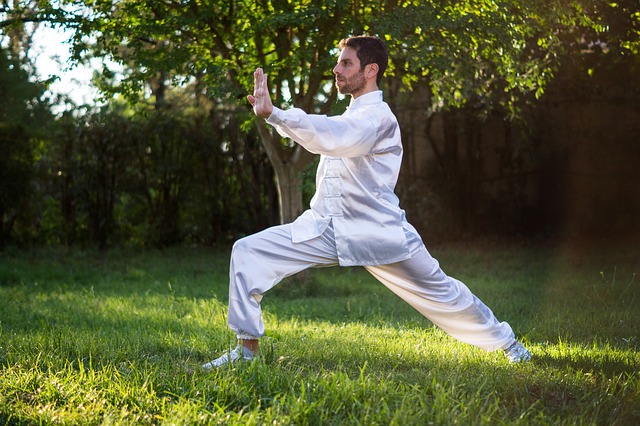Developed originally in China as a self-defense strategy, or martial art, t’ai chi—the “supreme ultimate fist”—is practiced in modern times primarily as a gentle exercise technique.
Described as “meditation in motion,” t’ai chi consists of a standing person performing a series of postures or bodily movements in a slow and graceful manner, with each movement flowing without pause to the next.
According to Chinese legend, the technique was created by a Taoist monk who was inspired as he watched a crane and a snake do battle.
Impressed by the snake’s ability to subtly and swiftly avoid the bird’s thrusts, he devised a series of self-defense techniques that do not involve meeting the opponent’s force with force, but rather stress evading the blow; causing the opponent’s own momentum to work against him.
T’ai chi is an ancient form of exercise, about 2,000 years old, that at one point had over 100 separate movements or postures.
In current practice, there are two popular versions, of 18 and 37 movements respectively. The fact that in China 10 million people practice some type of t’ai chi daily suggests that it is one of the most popular forms of exercise in the world.
In the United States, t’ai chi is learned in classes in which students (or “players,” as they are called in China) wear loose, comfortable clothing and either go barefoot or wear only socks or soft shoes on the feet.
In China, t’ai chi is almost always practiced outdoors at dawn, and ideally near trees. Unlike other martial arts, t’ai chi is not competitive. Classes usually begin with a few minutes of standing meditation to calm the mind and gather energy.
Following warm-up exercises, students are taught the basics of a particular form or posture. Learning forms is not easy, and it takes some time to master what looks like a simple position.
Properly done postures are done in a relaxed, artful, and linked way, with the circular and rhythmic movements of one position flowing seamlessly into the next.
While strict attention to body position is critical, proper breathing is considered to be equally important. Just as movements are slow and continuous and without strain, breathing should be effortless yet deep.
Finally, both mental and physical balance is considered essential to t’ai chi. The experienced practitioner of t’ai chi maintains perfect body balance throughout the exercise series. Altogether, the five essential qualities of t’ai chi are:
* Slowness. To develop awareness.
* Lightness. To make movements flow.
* Balance. To prevent body strain.
* Calmness. To maintain continuity.
* Clarity. To focus the mind.
T’ai chi has both physical and mental benefits. If done regularly, it improves muscle tone, flexibility, balance, and
coordination. Many older people find that it boosts their energy, stamina, and agility, sharpens their reflexes, and gives an overall sense of well-being.
The calming and meditative aspects of t’ai chi allow many to experience its ability to relieve stress. Some claim t’ai chi to be a healing therapy, and it is often used to support other treatments for chronic conditions; arthritis and digestive disorders are just two examples.
Like yoga, t’ai chi has several different styles to suit the individual. Also, it can eventually be done daily by oneself, and ultimately becomes a very personal endeavor.
Most Westerners find it best to practice t’ai chi in the same place and at the same time of day, and those who enjoy it most are those who are not seeking major, dramatic breakthroughs, but rather who can take pleasure in small gains that accumulate over a long period of time.






